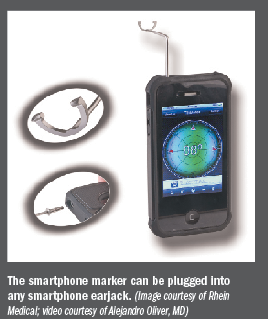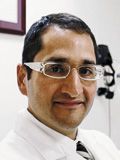Article
Smartphone marker serves as toric point of reference
A new device that can be plugged into a smartphone earjack is a convenient, easy way to make reference marks on the eye for placement of toric lenses and limbal incisions.
Take-home:
A new device that can be plugged into a smartphone earjack is a convenient, easy way to make reference marks on the eye for placement of toric lenses and limbal incisions.

By Nancy Groves; Reviewed by Alejandro Oliver, MD, MSc, FRCS, and Roger Steinert, MD
With that smartphone in the pocket of an ophthalmologist’s white coat, a level app, and the marker plugged into the earphone jack, it’s easy to make accurate radial marks at 3 and 9 o’clock or at the desired final axis, according to two physicians who came up with the idea for a novel device.
The smartphone marker (Steinert/Oliver Smart Phone Marker, Rhein Medical) takes advantage of the ubiquity of smartphones to offer surgeons a convenient method of astigmatic marking.

Dr. Oliver
“Everybody has an iPhone or an android device or some kind of smartphone available,” said Alejandro Oliver, MD, MSc, FRCS, an ophthalmologist with the Northern Ontario School of Medicine, Canada. “These devices have become true portable computers, and we wanted to harness that power and the features that already exist and apply them to the problem of toric lenses.”
Dr. Oliver and Roger Steinert, MD, chairman, Department of Ophthalmology, Gavin Herbert Eye Institute, University of California, Irvine, independently thought up smartphone marking and approached Rhein Medical, which then put them in touch to collaborate on the design of a prototype.
VIDEO
There are many level apps for smartphones, many of them free, Dr. Steinert said. They utilize the phones’ built-in accelerometer-the highly sensitive position sensor that rotates the screen between vertical and horizontal.
The two physicians wanted to apply this capability to surgical marking in situations, such as placement of toric lenses or making limbal incisions.
Toric lenses can make a big difference in vision following cataract surgery, Dr. Oliver said, but surgeons don’t always get the “wow effect” because of high astigmatism.
“The key to a good toric result is to orient the IOL properly,” he said. “There are numerous devices on the market to mark the correct axis for the patient.
“I thought that by using the accelerometers that are built into a smartphone, which can measure the degree of tilt, we could harness that power,” Dr. Oliver said. “And by adapting it to a simple two-hashmark, purpose-built marker, we could integrate the two for a very simple yet elegant solution.”

Dr. Steinert
The challenge was to design a marker that could be attached to any smartphone. This was initially an obstacle, since not only are there numerous brands of phones, but their designs frequently change.
“The eureka moment was to adapt the toric marker to the earphone jack, which all smartphones have, and it’s universal. It doesn’t change,” Dr. Oliver said.
For more than a year, Dr. Steinert and Dr. Oliver, each initially on their own and then in collaboration, worked on prototypes.
“We finally came up with this last version, which we’re very pleased with,” Dr. Oliver said.
Accuracy has been an issue with astigmatic marking, said Dr. Steinert, explaining that when using a pen, the ink itself can be as much as 5 degrees, and the line may not be perfectly level if just assessed by eye, not with an instrument.
“The smartphone marker is a way of getting a very fine, precise mark,” he said, adding that it is a straightforward, practical method to make accurate measurements.
The device is not necessarily more accurate than other marking techniques, noted Dr. Oliver. The points in its favor are the convenience, given the fact that nearly every doctor carries a smartphone, and that it’s a low-cost, efficient solution
“You already have a toric marker in your pocket, so to speak. You just need the right adapter,” he added.
“It’s a very simple, effective, elegant solution, and I hope people are at least willing to give it a try,” Dr. Oliver said.
Reviews and feedback from other ophthalmologists have been favorable, he added.
Alejandro Oliver, MD, MSc, FRCS
P: 705/267-1744
Roger Steinert, MD
P: 949/824-8089
Drs. Oliver and Steinert have a financial interest in this device.
Subscribe to Ophthalmology Times to receive the latest clinical news and updates for ophthalmologists.
Newsletter
Don’t miss out—get Ophthalmology Times updates on the latest clinical advancements and expert interviews, straight to your inbox.




